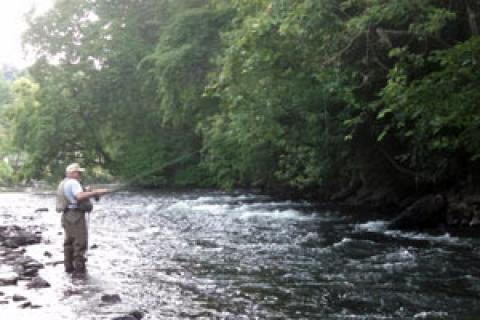
Wet flies — and the use of them — have become somewhat of a lost art in the realm of fly fishing for trout. Which is unfortunate, as wet flies are both easy to fish and productive. So when my friend Mark mentioned to me that he'd had a good day on a well-known central Pennsylvania trout stream while "swinging" soft hackle wet flies, I convinced him he should make a return visit, with me along.
Why Wet Flies?
Soft hackle wet flies are an example of simplicity, often no more than a subtle body tied of silk, with a light wrap or two of partridge hackle at the collar. In the water they can represent many life stages of an aquatic insect, from an emerging bug to a drowned one now suspended in the stream. Since these various stages are found in differing levels in the water column, one pretty much can't show a soft hackle in a way that might not result in a bite from a trout.
Swinging It
The traditional way of fishing a soft hackle is by way of the swing. Whereas in other forms of fly fishing, such as with dry flies or nymphs, the presentation is made upstream so the fly (flies) drift back down drag free, it's effective to fish wet flies downstream. You make a cast across the current, mending the line as necessary so the pseudo bug drifts naturally, and then allow it to hang in the current at the end of the drift. Thus the term "swinging" a wet fly.
Essentially you're casting the fly out in the flow, and then letting it swing downstream. Since the line is tight during the entire presentation, there's little doubt when a trout takes the fly. Many bites happen at the end of the swing, when the fly lifts up to the surface like an emerging bug. You can impart a few twitches at this point to coax a fish into hitting.
The More, the Better (if Legal)
It's also common to fish multiple wet flies at once. Laws differ from state to state on the maximum you can fish; in my state of Pennsylvania, the number is three, though I usually fish only two.
There are many ways of rigging multiple flies. Here are two of the most common:
- Leave a tag end of 6-8 inches when you tie the tippet to the leader. Use this tag as a dropper for a second wet fly (the other attaches to the end of the tippet).
- Tie a wet fly to the end of the tippet, in the traditional manner.
- Then tie a short section of tippet material to the bend of that fly's hook with a uni-knot.
- Tie the second fly to then other end of the tippet material.
Mark and I didn't set the world on fire during our outing to Pennsylvania's Little Juniata River. But we did manage to land a few wild brown trout by swinging wet flies. Not bad considering we fished the middle hours of a hot mid-July day. And we certainly gave other methods — including nymphs and dry flies — their chances.
- 5197 views

